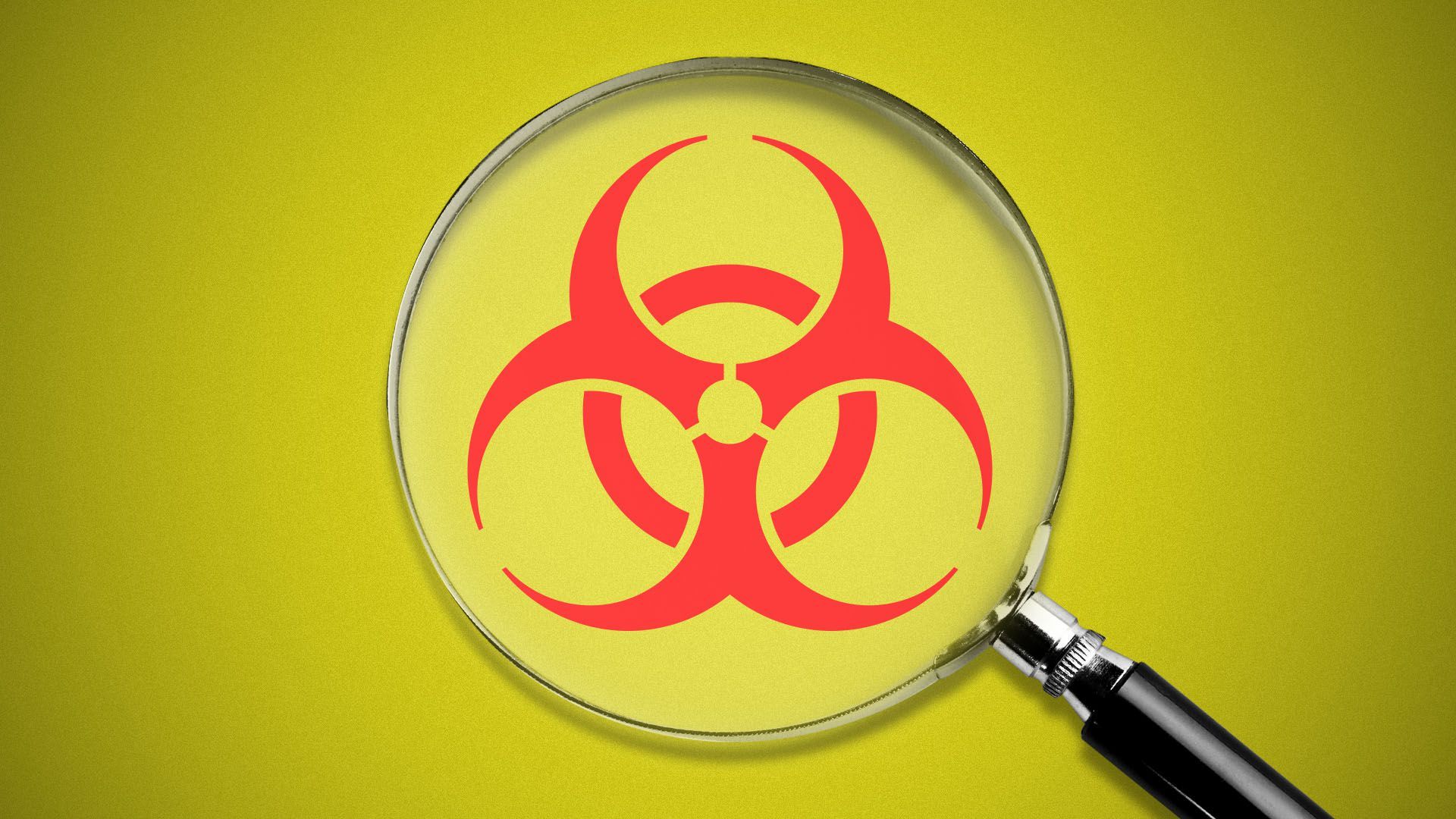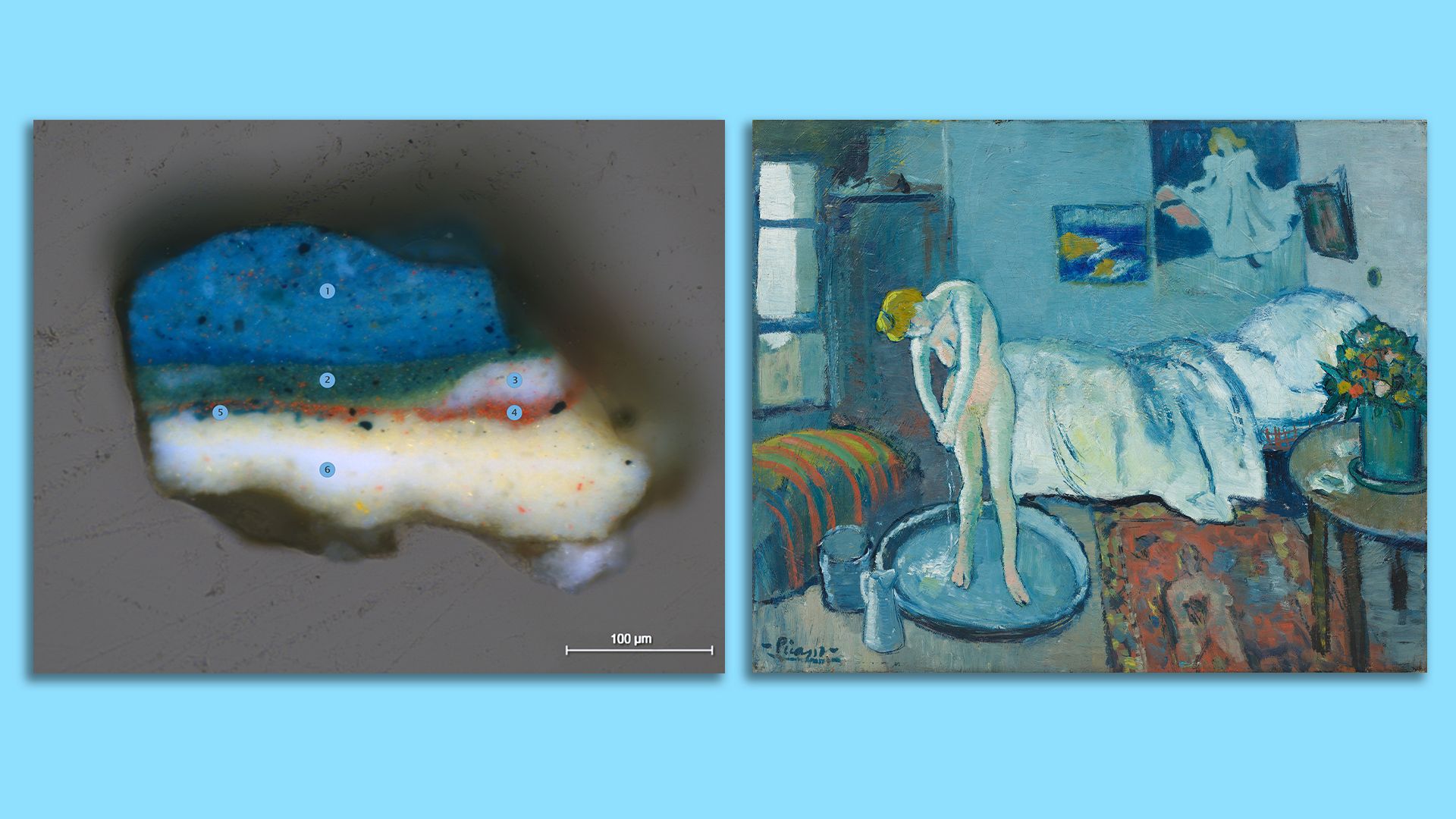| | | | | | | Presented By PhRMA | | | | Axios Science | | By Alison Snyder ·Mar 17, 2022 | | Thanks for reading Axios Science. This week's newsletter is 1,627 words, about a 6-minute read. | | | | | | 1 big thing: False flag forensics |  | | | Illustration: Shoshana Gordon/Axios | | | | The White House has warned Russia could use unsupported claims about biological and chemical weapons development in Ukraine as cover for escalating the war there, underscoring the power — and limits — of chemical and biological forensics. The big picture: Allegations that chemical or biological weapons have been used can be difficult to investigate and are one way for a country to create a pretext for aggression. - Tying a chemical or pathogen to a source and attributing it to an actor can be a long, tedious process that doesn't necessarily produce definitive answers.
How it works: A suspected or alleged chemical attack or incident can be investigated by the Organization for the Prohibition of Chemical Weapons (OPCW) or, for biological weapons, by the UN Secretary General or through countries that are part of the 1972 Biological Weapons Convention (BWC). - Investigations consider an array of evidence, including analyses of samples from the site (which can be difficult to access), interviews with witnesses, and collecting and deciphering epidemiological data as well as more traditional forensics of munition fragments, fingerprints, fuses and other traces of the incident.
- Confirming a chemical or biological agent was used at a location or determining how it was made relies on standard tools in chemistry and biology: DNA and RNA sequencing and microscopy for analyzing biological samples; mass spectrometry, gas chromatography, NMR and others for chemical forensics.
A signature of a pathogen's source is its genetic sequence, which can have different patterns compared to other samples of the same microbe, because of recombination and mutations. - In chemicals, the constituent atoms don't vary from one molecule to the next. But impurities, additives, byproducts or other "gunk and junk," as Dan Kaszeta, who has worked in chemical and biological defense for the U.S. Army and other agencies, describes it, can indicate how and where a chemical agent was made.
- Byproducts and the additive hexamine linked a sarin attack in the Syrian town of Khan Sheikhoun in 2017 to the Assad government, according to a OPCW-UN report. Syria and Russia, which supports Assad's forces, deny chemical weapons were used and blame insurgents.
Yes, but: Determining who used a chemical or biological agent "tends to be much more complicated than just the chemistry or biology," Kaszeta says. - In Syria, the probative information was hexamine in the sarin but the smoking gun was a document in which the Syrian government, when it joined the OPCW in 2013, declared hexamine as part of their chemical inventory, he says.
- In the 2001 anthrax attacks in the U.S., the spore samples in letters sent to victims were, after six years, matched to a batch of a particular anthrax strain accessible to only a few people, a breakthrough that helped narrow the suspects and ultimately identify Bruce Ivins as the mailer.
What to watch: Gregory Koblentz, director of the Biodefense Graduate Program at George Mason University, says that, rather than use a chemical or biological weapon for an attack in Ukraine, there is a risk "Russia will invent or stage an event, claim it as an atrocity and use it domestically for escalating their commitment to the conflict." - Another concern for Koblentz is that unsubstantiated claims that bioweapons are being developed in Ukrainian labs that study and surveil pathogens like Crimean hemorrhagic fever could damage international cooperation on biosecurity and pathogen surveillance among labs around the world.
Read the entire story. |     | | | | | | 2. Americans aren't convinced about brain enhancement tech |  Data: Pew; Chart: Will Chase/Axios Americans are wary of potentially widespread use of several human enhancement technologies in the future, but many say they'd likely want to use some of the tech for themselves, a new Pew survey finds. Why it matters: Public sentiment — and uncertainty — can help to shape what guardrails governments and other institutions place on emerging technologies. By the numbers: Pew asked 10,260 U.S. adults about their views on several applications of AI as well as gene editing of embryos, robotic exoskeletons for manual labor and computer chip implants for the brain, which aren't widely used now. - More than half said computer brain implants that could improve someone's cognitive abilities would be a bad idea, 31% weren't sure and just 13% responded that the technology is a good idea for society.
- 33% said the use of robotic exoskeletons to increase people's strength for tasks would be a good idea. 24% thought the technology would be a detriment.
- 30% of people surveyed said gene editing of embryos to reduce the risk of someone developing a disease would be good for society — and 30% said it would be bad. (39% weren't sure.) The findings echo those from earlier surveys.
But, but, but... Almost half of Americans said they would want gene editing for their own babies, and 45% said they would want robotic exoskeletons for themselves. - Most Americans (73%) said they would feel pressure to use embryo editing for their own babies.
- Between the lines: The responses reflect Americans' concerns about human enhancement tech creating — or exacerbating — inequalities.
What to watch: There are some conditions that Americans say would make human enhancement acceptable. - About half of Americans said they'd be more accepting of gene editing embryos for specific conditions or diseases, or if the changes wouldn't be inherited by future generations.
|     | | | | | | 3. Catch up quick on COVID | | Pfizer says a fourth shot of its coronavirus vaccine will soon be needed for at least some Americans, raising questions about the vaccine's utility in the long run, Axios' Caitlin Owens writes. New data suggests Johnson & Johnson's coronavirus vaccine "is preventing infections, hospitalizations and deaths at least as well as the Pfizer-BioNTech and Moderna vaccines," Apoorva Mandavilli reports in the NYT. A possible connection between COVID-19 and diabetes is being studied by researchers, the AP's Lindsey Tanner writes. |     | | | | | | A message from PhRMA | | Voters want Congress to address health insurance | | |  | | | | According to a new poll, 71% of Americans would like to see Congress focus more on reducing the overall costs of health care coverage such as premiums, deductibles and copays. The reason: Many believe current health insurance coverage options are confusing and unaffordable. | | | | | | 4. Picasso: Beneath the Blue |  | | | Paint microsample, 200x magnification, showing the sequence of paint layers near the shoulder of the figure in Pablo Picasso's "The Blue Room" (1901). Photo: Patricia Favero, The Phillips Collection. Pablo Picasso, "The Blue Room," 1901, Oil on canvas, 197/8 x 24 1/4 in. The Phillips Collection, Acquired 1927 ©2022 Estate of Pablo Picasso/Artists Rights Society, New York | | | | Beneath some of Picasso's iconic paintings, researchers are finding new details about hidden portraits and compositions. Why it matters: The discoveries, being presented in a new exhibition, offer clues about the artist's materials and process early in his career — and how to better conserve his work. "The technical studies were able to inform art historical research at a new level," says Patricia Favero, an associate conservator at the Phillips Collection in Washington, D.C. - Favero is part of a team of conservators and scientists that studied three Picassos that are now in an exhibition about the artist's Blue Period.
- Earlier studies have used imaging techniques to study aspects of these and other paintings on recycled canvases, which Picasso was known to use.
- The first clue that there was a painting beneath "The Blue Room" (1901) was spotted more than 60 years ago. Some of the paint texture reflects brush strokes in different directions than the composition that is seen.
What's new: Combining data from X-radiography, infrared (IR) reflectance imaging spectroscopy, and X-ray fluorescence mapping, a team of researchers from the Phillips, the National Gallery of Art and other institutions were able to see a portrait of a man, indicators of the brush and strokes, and the pigments the artist used. For example, the presence of mercury suggests he was painting with vermilion. - Microanalysis of tiny samples of the painting indicate most of "The Blue Room" is painted directly on top of the portrait, without priming, and that Picasso's palette was becoming more subdued.
Infrared reflectance image (transform image from the infrared reflectance spectroscopic image cube) showing the portrait of an unknown man beneath Picasso's "The Blue Room" (1901), The Phillips Collection, Acquired 1927. The canvas is rotated 90 degrees clockwise. Photo: John Delaney and Kathryn Dooley, National Gallery of Art With IR reflectance spectroscopy, the researchers could see forms beneath the right shoulder and forearm of the woman in "Crouching Beggarwoman" (1902). - Using X-ray fluorescence scanning, the chemical elements in the paint were mapped, revealing information about the stages in which the painting was developed — an arm exposed, then later covered.
- Conservators already knew a landscape painting — its creator unknown but its range of colors is similar to Picasso's — was under the portrait, but the analyses provided new details about how the hills in the painting later became the back of the crouched woman.
A map of the elements in the paint of "The Soup" (1903) suggests Picasso changed the shape of the bowl being offered to a child by a woman and that he altered the woman's gesture and how her hair fell from her forehead. - Other imaging tools suggest the painting was first a still life, parts of it scraped off rather than painted over.
The bottom line: "There is still more to learn from some of the world's most studied paintings," Favero says. |     | | | | | | 5. Worthy of your time |  | | | A cropped image of the star 2MASS J17554042+6551277 and galaxies taken by JWST during its alignment process. Photo: NASA/STScI | | | | James Webb: "Fully focused" telescope beats expectations (Jonathan Amos — BBC) Ancestral dreams (Sidarta Ribeiro — Aeon) Russian scientists face isolation following invasion of Ukraine (Dennis Overbye — NYT) |     | | | | | | 6. Something wondrous |  | | | Acoustic fiber and fabric with fiber preform. Photo: Fink Lab MIT/Elizabeth Meiklejohn RISD/Greg Hren | | | | A new fabric woven from sensors mimics the human eardrum to hear, researchers reported this week. Why it matters: The material could be used to create clothes that could help a wearer hear or observe someone's heart beat and other body functions. How it works: It is essentially a fabric microphone, the researchers led by Wei Yan from MIT write in Nature. - A single fiber of piezoelectric material — which generates electricity when pressure is applied to it — is woven with cotton and a synthetic fiber called Twaron.
- Sound from the environment vibrates the fibers of cotton and Twaron.
- Those vibrations are then turned into electrical signals by the piezoelectric material.
"The buckling and bending of the piezoelectric-containing fiber create electrical signals that can be sent through a tiny circuit board to a device that reads and records the voltage, Carolyn Wilke writes in Science News. - All fabrics vibrate from sound but the signals are small. The new fabric enhances the signal by concentrating the energy from the mechanical vibrations in the piezoelectric layer, per Wilke.
What they found: The researchers made a shirt from the fabric that could hear someone's heartbeat. Another garment could detect the direction of a sound, like a clap, and could also project sound. - And it still worked after washing it 10 times.
Go deeper. |     | | | | | | A message from PhRMA | | Voters want Congress to address health insurance | | |  | | | | According to a new poll, 71% of Americans would like to see Congress focus more on reducing the overall costs of health care coverage such as premiums, deductibles and copays. The reason: Many believe current health insurance coverage options are confusing and unaffordable. | | | | Thanks to Shoshanna Gordon and Aida Amer on the Axios Visuals team for their work on this week's edition and to Carolyn DiPaolo for copy editing. |  | It's called Smart Brevity®. Over 200 orgs use it — in a tool called Axios HQ — to drive productivity with clearer workplace communications. | | | | | | Axios thanks our partners for supporting our newsletters. If you're interested in advertising, learn more here.
Sponsorship has no influence on editorial content. Axios, 3100 Clarendon Blvd, Suite 1300, Arlington VA 22201 | | | You received this email because you signed up for newsletters from Axios.
Change your preferences or unsubscribe here. | | | Was this email forwarded to you?
Sign up now to get Axios in your inbox. | | | | Follow Axios on social media:    | | | | | |
No comments:
Post a Comment